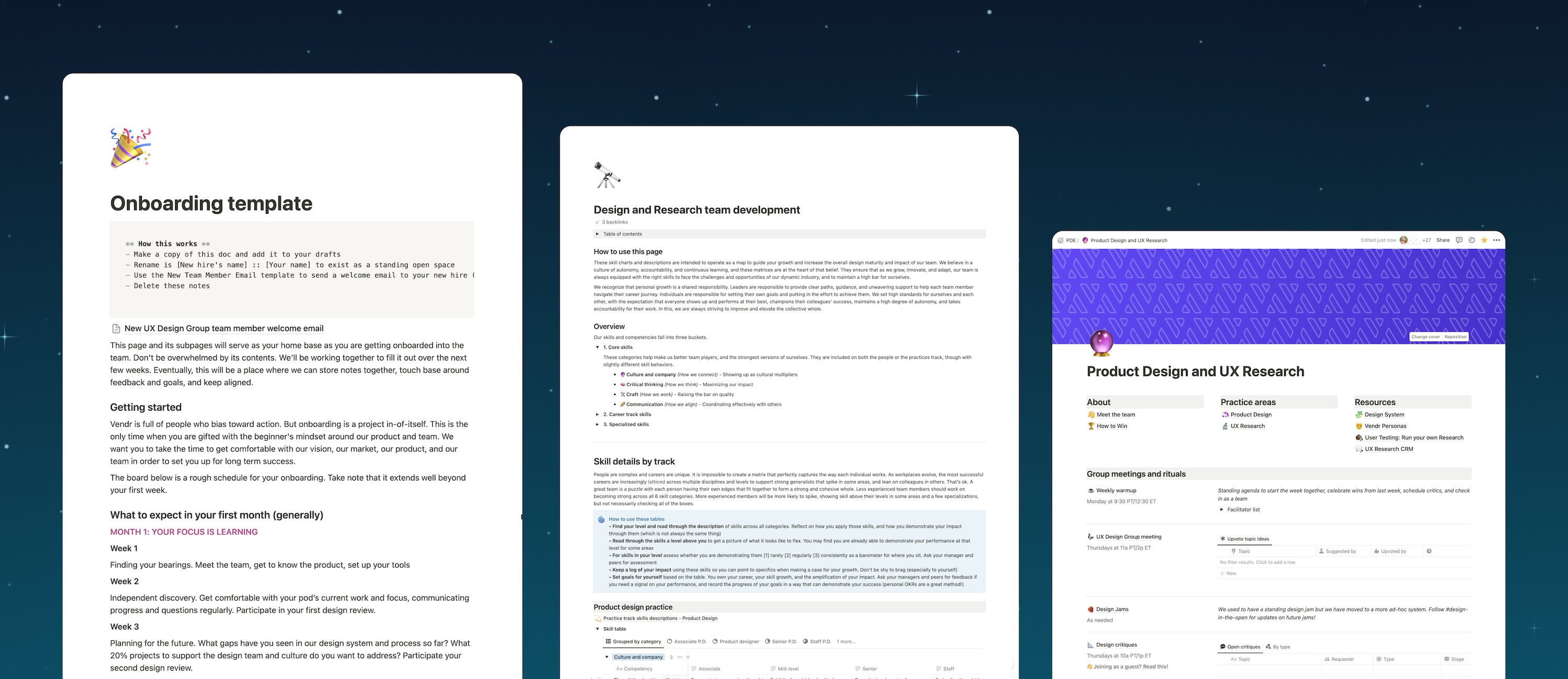
Building a high impact design team and culture at Vendr
When I joined Vendr, the company had just acquired a SaaS management platform and was building their product development culture. The design team was nascent and the culture non-existent. A single Product Designer made up the entire discipline, with no UX Research representation. Within a year I had established a core design practice, expanded our design system, implemented structure to guide the design and critique process, introduced an interviewing and onboarding process, and expanded the team to meet the demands of our next phase of growth.
Impact
During my tenure I established design as a core discipline and peer to engineering and product management, and grew the team to meet our goals. By implementing design sprints, critique, design systems governance, career development, and a design validation and evaluation process, our contributions helped increase the overall quality of the product and experiences. This was quantified though a red route and core journey framework evaluative framework using CSAT and SUS that showed steady improvements, nearing or exceeding industry standards across the product.
Role
Senior Director of Product Designer and UX Research
Team
COO, COS (engineer), content manager, header of sales
My approach to shaping a great culture has four parts:
- Foundation
My leadership style will have an outsized impact on the culture of the team I design. Make it clear, transparent, and intentional. - Growth
The strength of the team starts with individuals. Ensure that we can efficiently meet our hiring needs while filling skill gaps and growing the overall quality and strength of the team.
- Operations
Process should serve our needs and set useful constraints. Define flexible, shared practices that allow designers to effectively manage stakeholders and deliver consistently great results. - Vision
The best way to inspire talented people is to give them something ambitious to achieve with a clear goal at the end. I invested in developing this for the team and for individuals, supported by a culture that rewards leadership and growth mindset.
Defining my leadership style
The team we design reflects who we are as leaders. Just like any other product we design, it will inherit our biases, experiences, and principles.
To counteract this, I maintain an intentional leadership approach through regular reflection. Over time, I have constructed a User Manual that demonstrates how I lean into my strengths and weaknesses, how I lead, and how I support and define the success of the people in my department.
This document is available to everyone who reports to me, and I regularly share it while interviewing as well so people know what they would be signing up for.
Having this at my disposal at Vendr helped me have more candid conversations with candidates and employees. It gives people a shared language to ask me about what their success would look like at the company, and ensures I am screening up front for people who meet my expectations of having a growth mindset.
 View on Google Drive
View on Google Drive
My supportive-leadership approach begins on day one.
When I joined Vendr, onboarding consisted of a 30 minute meeting with members of the People team, and no follow up. New hires were given a checklist of things to watch or read, independently, with no structure of support or camaraderie.
I created a 3-month onboarding plan for each new member of the team. The bulk of the content was weighted towards the first week, structured day-by-day, to take people through our foundational documentation, ensure they had the right context for the people and tools they would be coming across, and keep new hires engaged while mitigating any sense of overwhelming.
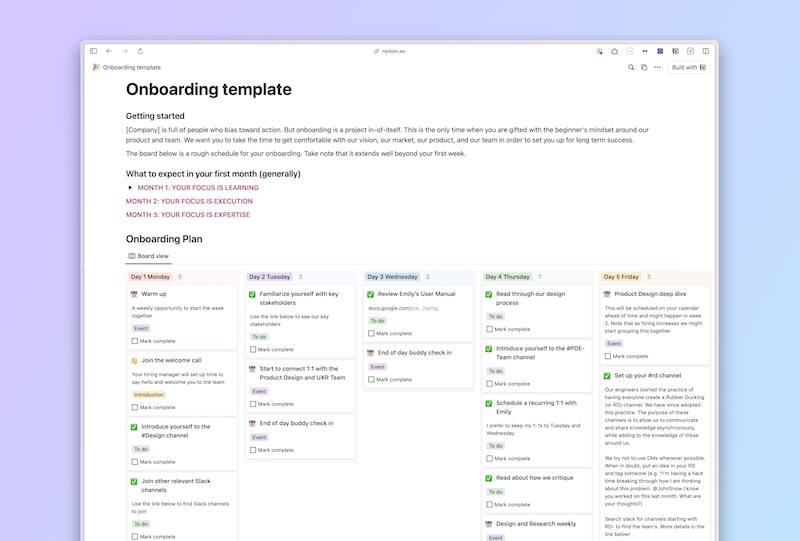

To support this experience, I implemented an onboarding buddy program so new hires felt connected to the team from day one (and to make sure I was not the bottleneck).
Every single person who joined my team told me this was the best onboarding experience they have ever had. Given that we are a fully remote company, this makes me particularly proud. On average, designers and researchers were contributing within their first two weeks.
“Emily gave me the agency and trust to do my best work at Vendr. She went out of her way to teach the team how to think about incorporating AI technologies into design and research work, provided us with the resources to put that into practice, and helped us be more assertive across all our work. I recall, on multiple occasions, leaders from product and engineering being in awe of Emily’s decisiveness, velocity, and assertiveness to make better decisions. This helped design have a seat at the table.”
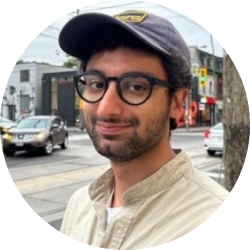
Karan Shastri
Staff UX Researcher (Vendr)
Designing our recruiting process
I started by overhauling our hiring process. Since we did not have an established design culture, very few people involved actually knew how to assess designers.
To counteract this, I built interview packets for each role including questions to ask, assessment criteria, and some information about what I would expect to hear from exceptional candidates.
This process had the added benefit of forcing me to get clear on the skills required for each role, and ensure that we were assessing the most critical skills effectively. As new roles opened up, I re-evaluated the skill focus of the role and included them with the role description.

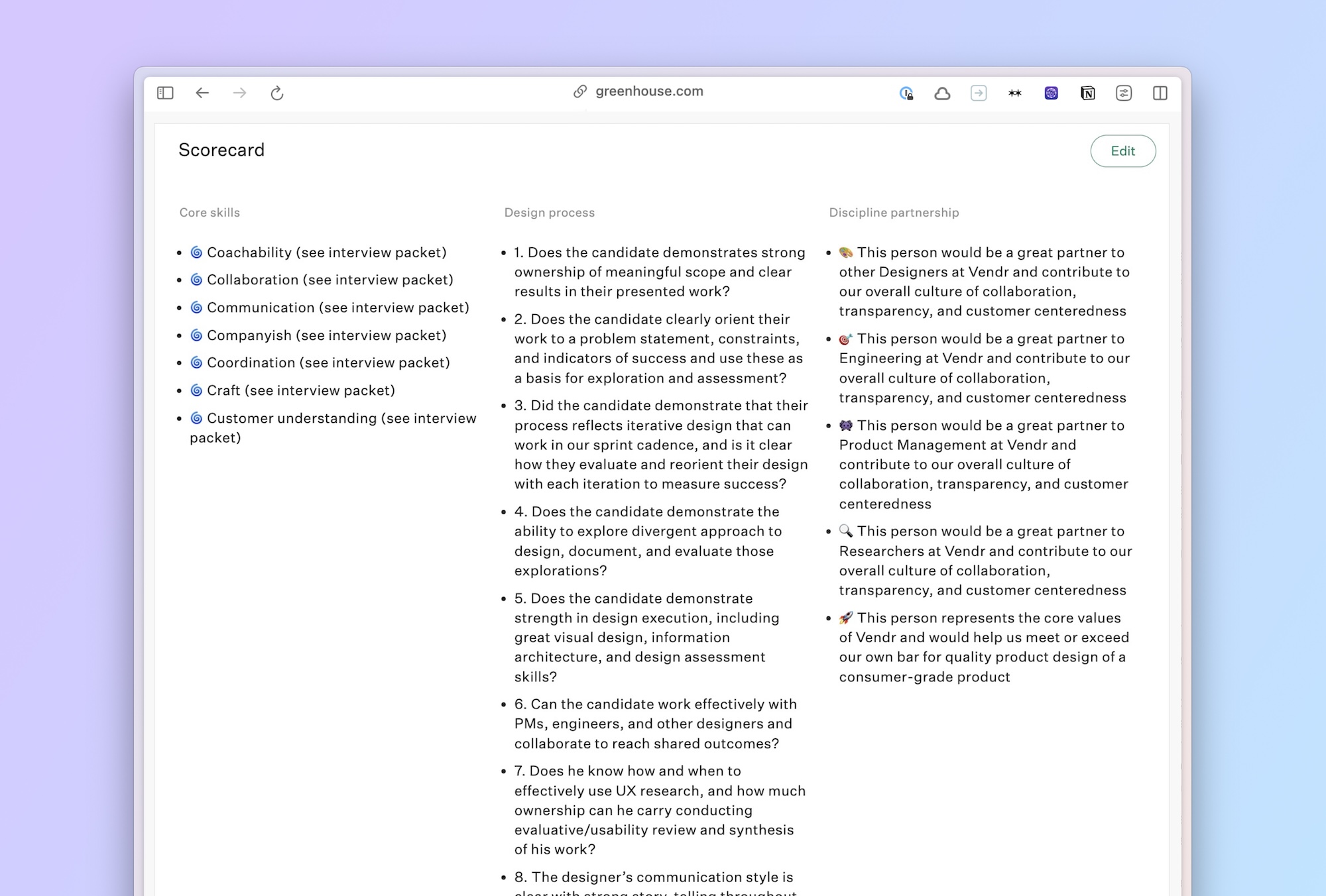
The result was a core interview panel that I could re-activate as needed when new jobs opened. With this format we were able to built an efficient process that led to excellent candidate moving quickly through the pipeline and feeling cohesion with the team from day one.
As a result, I was able to efficiently build a multi-faceted team with strong T-shaped people who complimented each other. This led to more cohesion and helped with design pairing and 1-1 support relationships, which built up our design culture.
“I wanted to say how much I appreciate your partnership on open roles. I've frequently had candidates comment on how they're even more excited about the chance to work at Vendr after meeting you. Your energy, empathy, and transparency are an excellent example of our culture and make it easy to sell candidates on our vision and the opportunity we have to make an impact.”

Steve Hagen
Principal Technical Recruiter
Freeing the team to do their best work
The overall product maturity was low at Vendr when I joined. Discovery was not consistent (or happening), and as a result it wasn't always clear that designers were working on the most impactful thing, or had the right information to validate their impact.
I aimed to ensure that design is a multiplier and not a bottleneck (real or perceived).
To mitigate that risk, I worked closely with peers in engineering and product leadership to develop a shared product development lifecycle process. This included standards for applying design early in the process during discovery through to evaluative research.
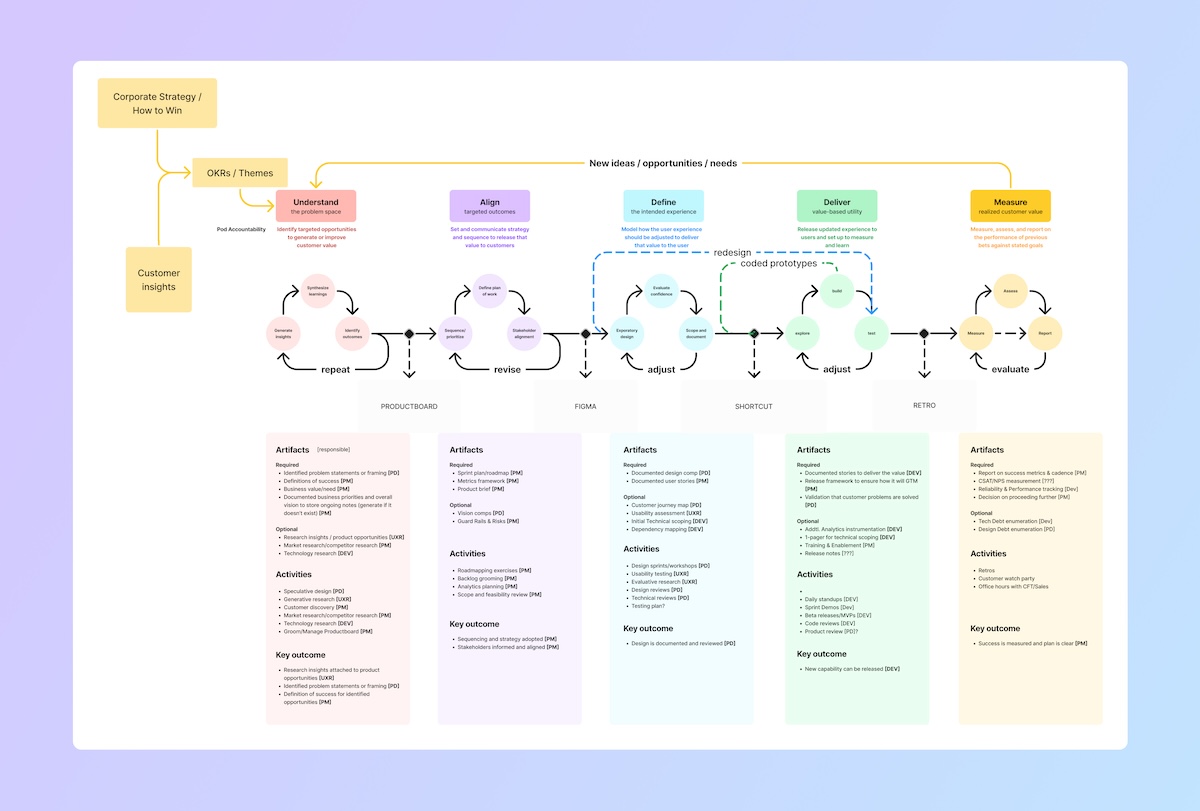
We ended up with a pseudo-journey for a collaborative pod (PM, EM, PD, UXR), including key artifacts and activities during a sprint.
This had the secondary effect of codifying our emergent principles and practices as a design team. Some highlights include:
- Design as an agent of discovery
- Design was given early visibility into upcoming product bets. This was achieved by (1) consistently reinforcing the expectation with peers in product management that designers should be at the table as early product concepts were discussed and (2) supporting UX researchers to run regular customer interviews and synthesis to keep a pulse on product opportunities.
- Transparent and inclusive design
- When a 2-week sprint kicked off, designers brought in collaborators early, sharing low-fidelity thoughts and holding open discussions so they could confidently move forward towards a shared solution.
- Iterative design and evaluation
- UX Researchers were paired in a 2:1 ratio with Product Designers, leaving ample time for evaluative research through the design process so designers could rapidly iterate and improve their work.
- Shared language with engineers
- Whenever possible designers worked off of pre-existing design system components. All compoenents were documented in the design file so variants and any new component candidates could be assessed in isolation of the larger design, as well as in context.
These were put into practice in 2-week sprints, combined with upstream planning exercises and beta periods for evaluating new features.
Regular sprints were supported by in-person design sprints and remote workshops around specific questions or goals. In these settings, designers acted as facilitators and participants, working with peers to better understand a problem and identify possible solutions.
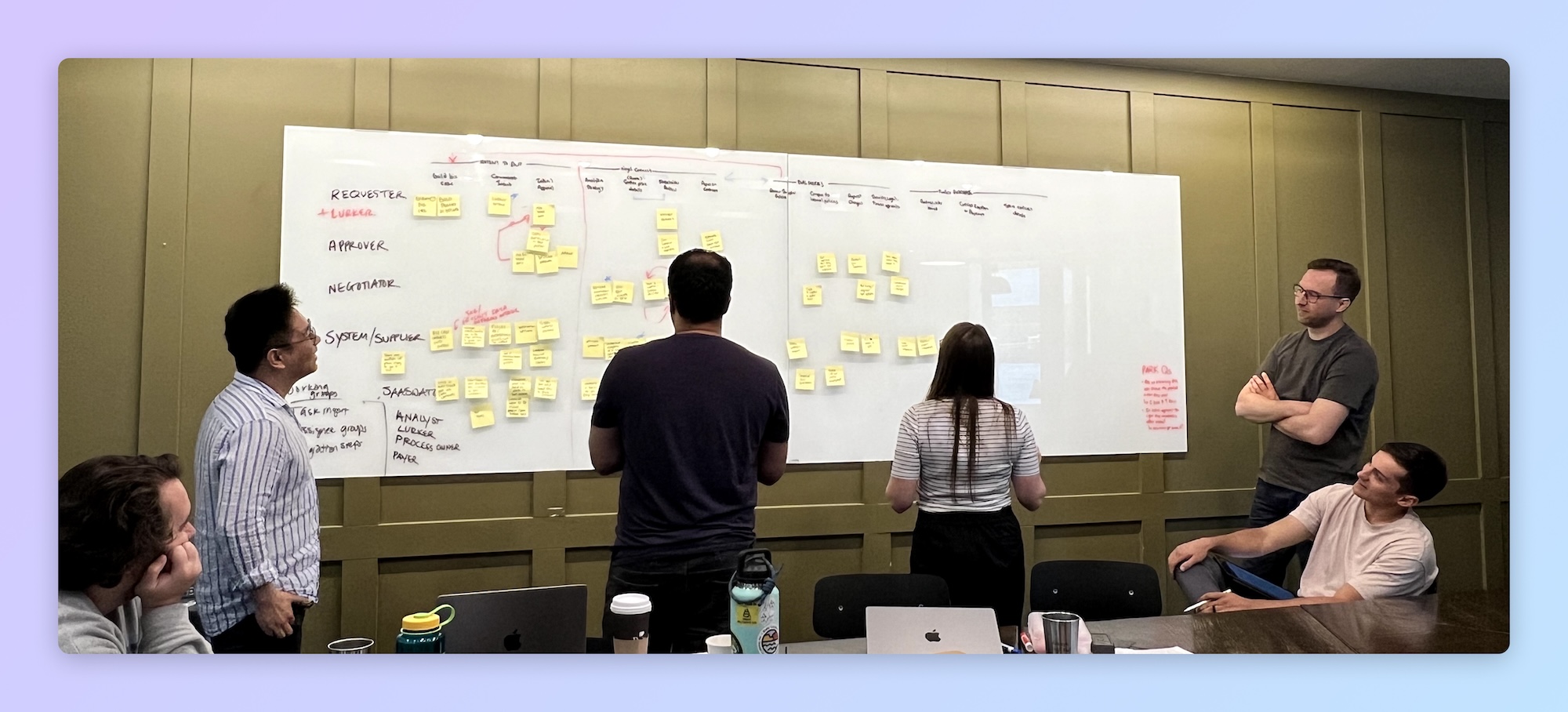

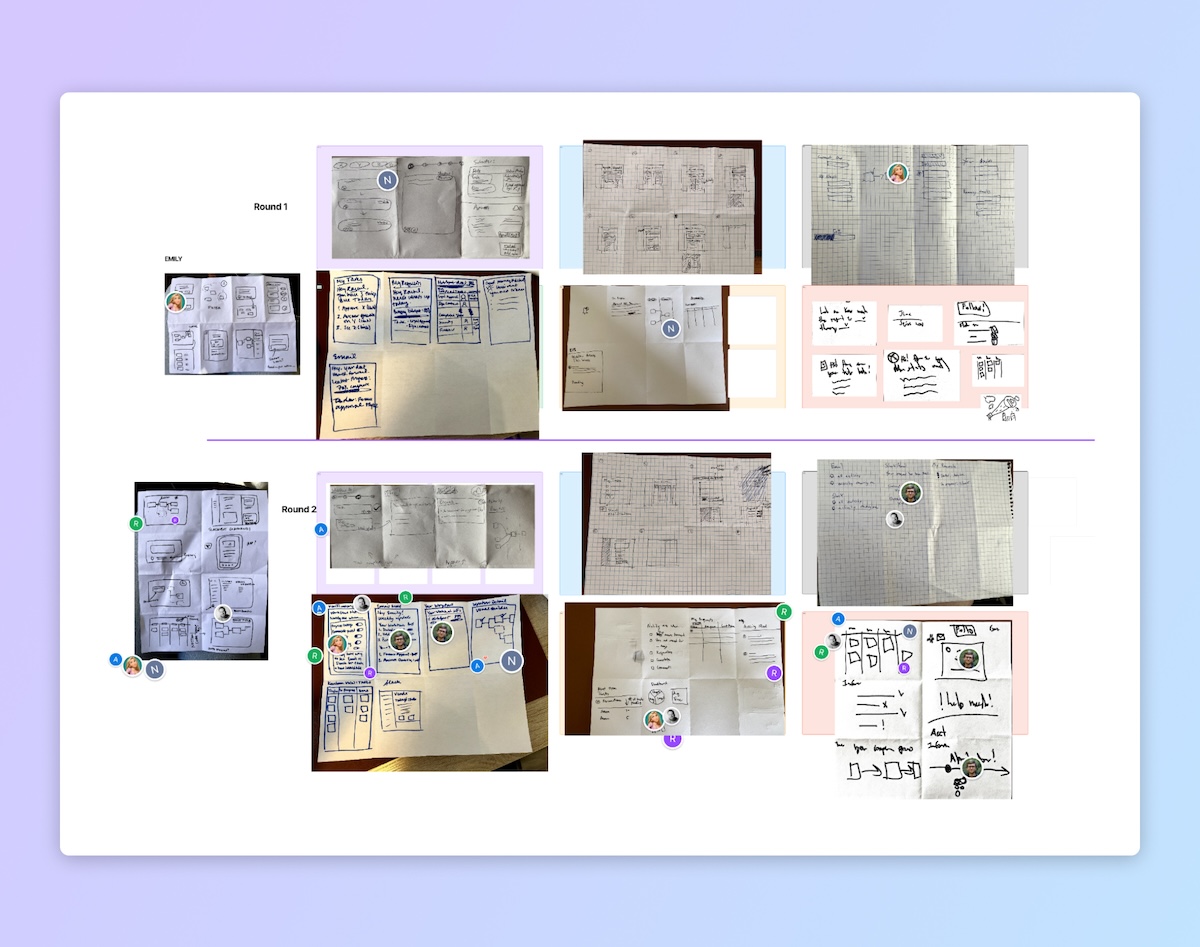
Finally, we developed a shared culture of critique. In addition to a weekly standing critique, designers regularly paired off for design jams, and invited in collaborators to provide feedback and explore alternative directions.
As a result of our consistent practices, design was positioned to have a direct impact on the product and on the business. Designers were empowered to work quickly and autonomously, had access to information and data that helped them iterate their work, and moved the needly forward in the user experience.
“By far the most data driven UX team I've ever seen!”

Michael Newton
Staff Engineer
“Emily Campbell was quite possibly the best manager I’ve ever had. Her candor, her design skills, and her compassion are unmatched.”

Alice Barton
Senior Product Designer
Building for the future
Over my career I have seen how great people respond to ambitious opportunities and clear goals. As I hired and coached people into forming a growth mindset, I worked to develop the tools and vision that would keep my talented team engaged.
To make the team's impact more visible, I created public channels where we could share our work, amplified our wins into company spaces, and pursued opportunities like presenting on our design culture to the entire company. Working in the open helped to make design empowered and impactful.
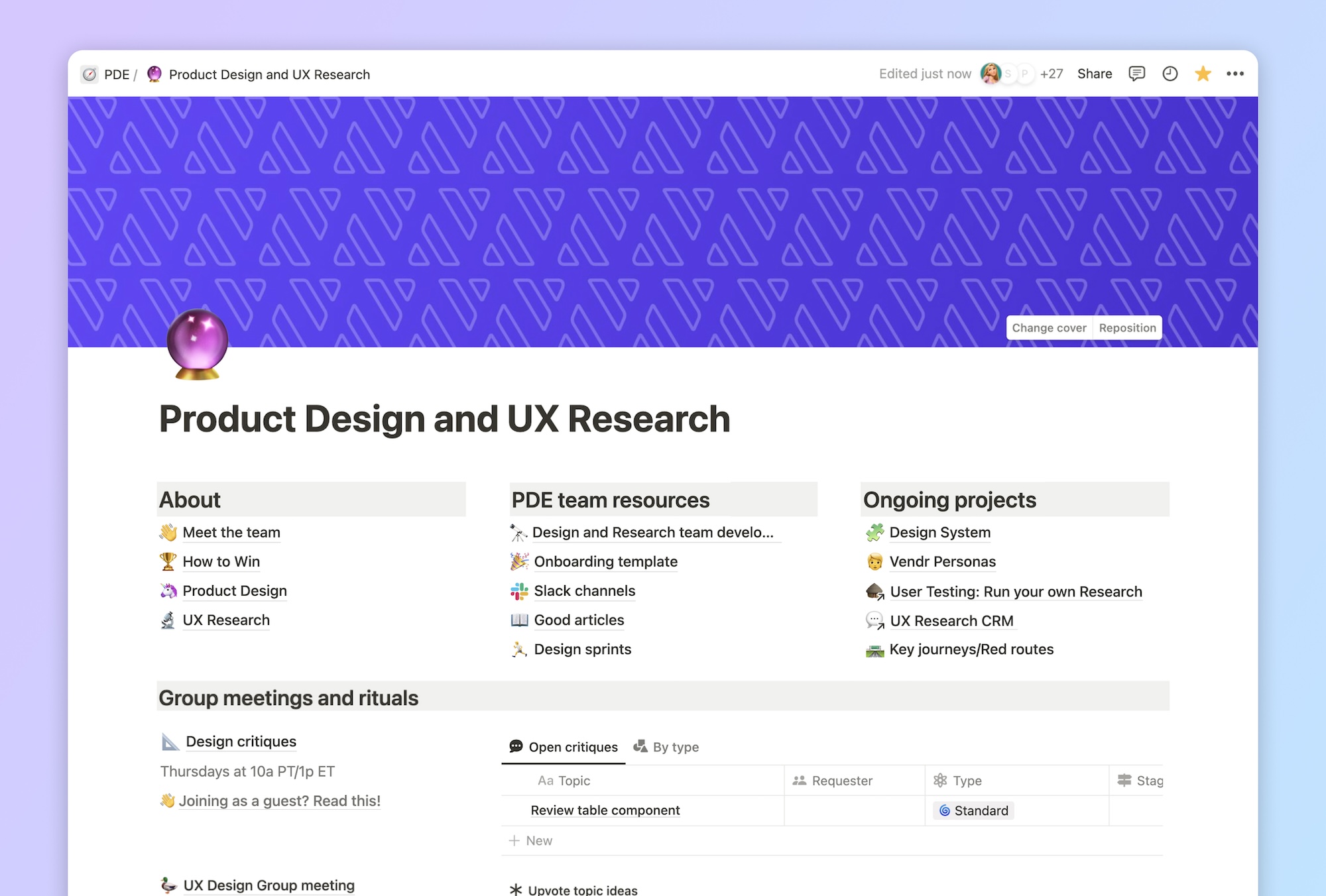
I worked with each team member individually to understand their goals and help them set up a path for growth. Depending on the person, this took many forms.
While the PDE organization as a whole chose to forgo performance reviews, I encouraged people on my team to seek out 360-degree feedback and contributed to reviewing that feedback and providing my own perspective.
Using the language of my User Manual I invited candid conversations about which skills I saw needing development, and helped people visualize what "better" looked like so they saw this as a positive challenge.
In addition to these day to day investments, I focused on putting individual growth in the hands of the people themselves. To accomplish this, I created a full growth path for every role, current and future, within our department, including specific skills and examples of impact.
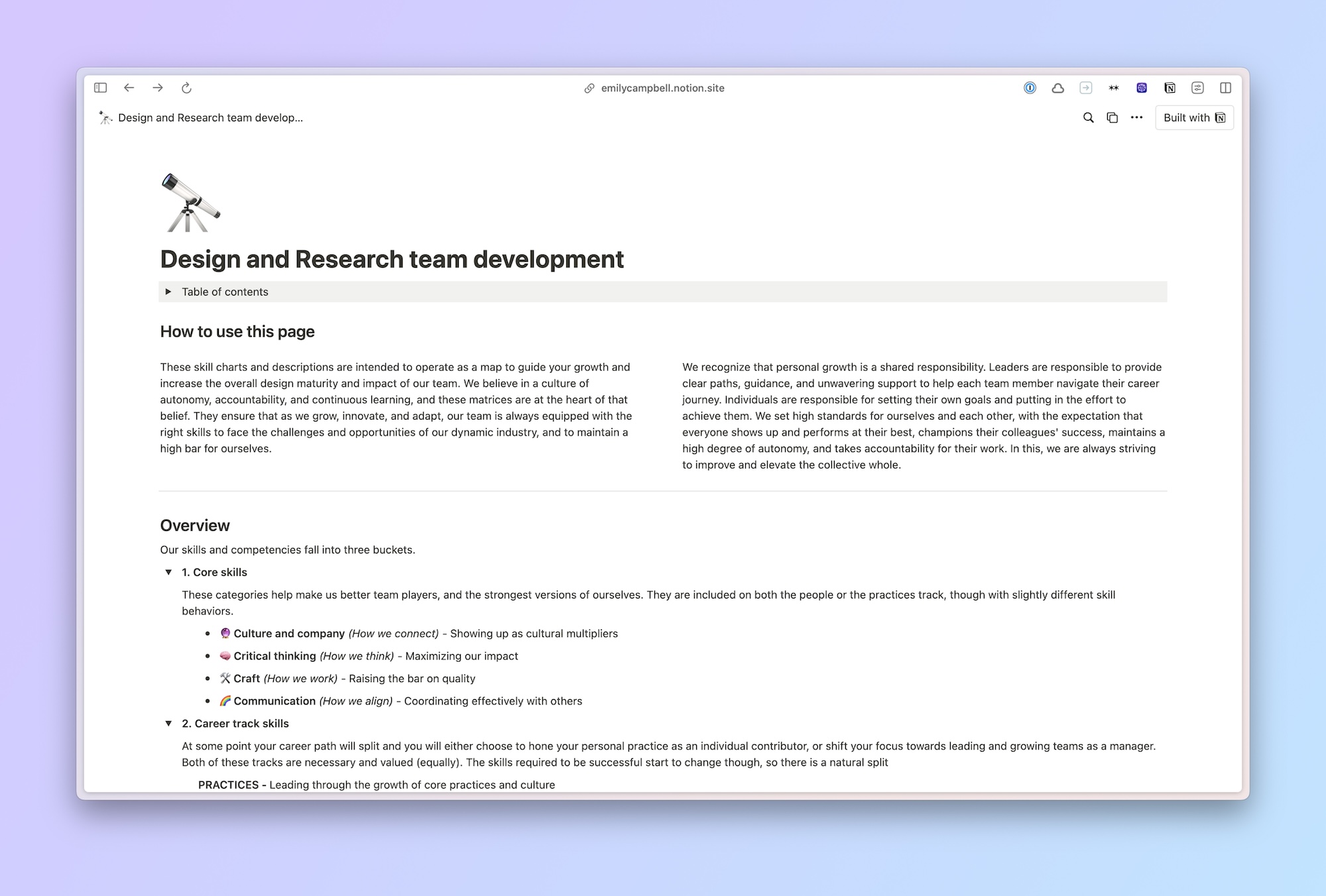
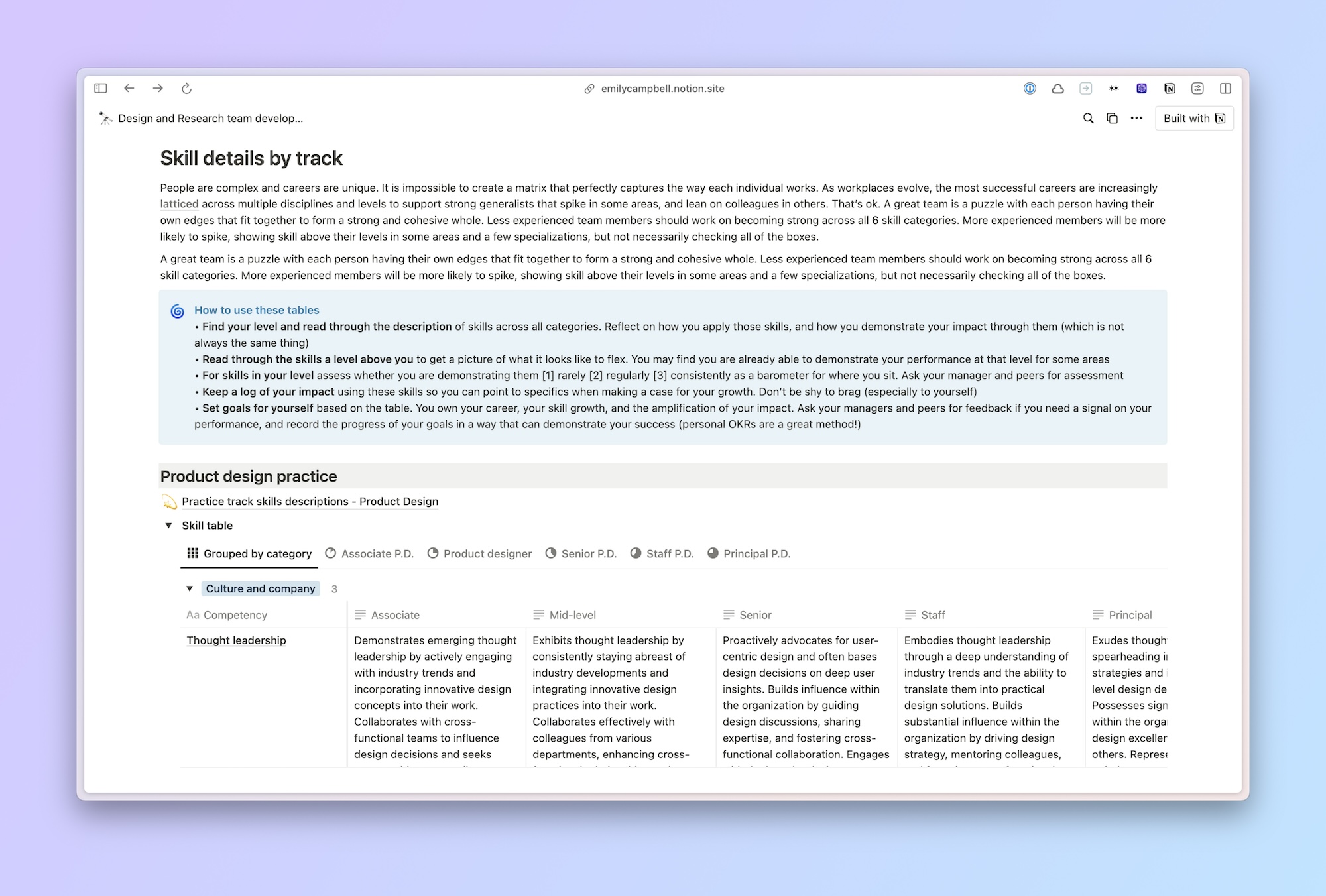
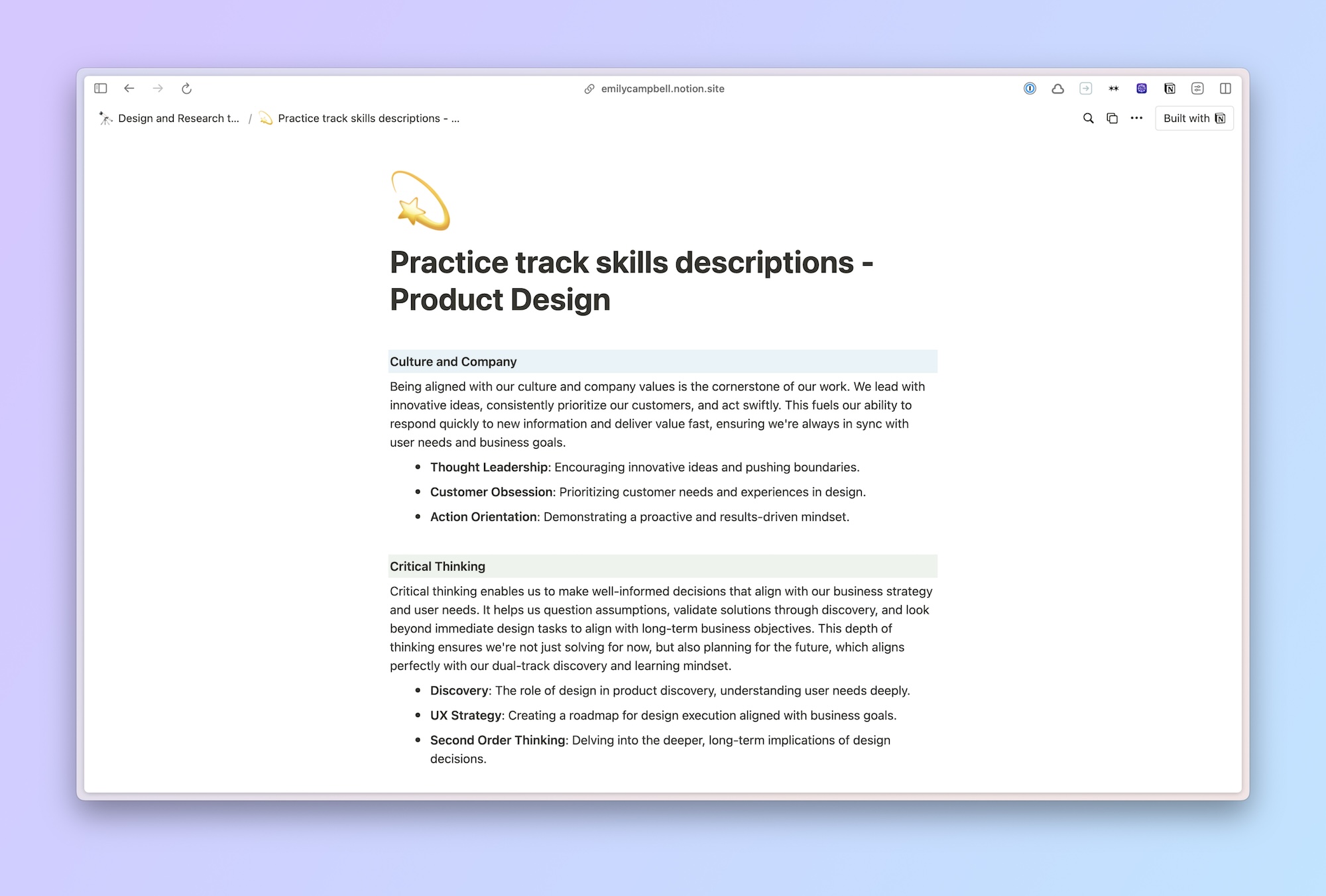
“One of the biggest things we were missing before you joined Vendr was a healthy design culture and the design team having an environment that supported growth. It seems to me that you made that happen. It’s so much better today than it was before you joined and I attribute that to you directly.”

Matt Daubert
VP of Engineering (Vendr)